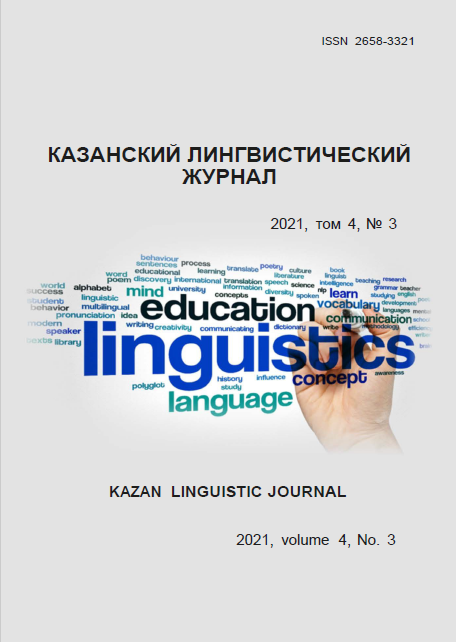Analysis and genesis of translation errors
https://doi.org/10.26907/2658-3321.2021.4.3.392-410
Keywords:
translation errors, norms of translation, Russian e Italian language, hypnosis of the word in translationAbstract
The present study is aimed to investigate and analyze the translation errors committed by Italian students who study Russian, and identify the source of errors in order to improve their translation ability. The concept of error has been analyzed from a linguistic and cognitive point of view. It has been also argued that non-strictly linguistic factors, such as demotivation, disattention, apathy, as well as hypnosis of a word, may also be responsible for error сommitting. It has been noted that errors are determined by the negative effect of many factors, but the main factor is to treat the translation process not as an integrated activity, but as a mere substitution of the words of one language with the words of another language, as literal translation is easier and faster. An integrated errors classification based on Komissarov’s view of translation errors [1] is provided. According to this classification, translation errors are divided into competence errors and performance errors. It has been noted that the competence errors are the most serious, since there is divergence from the original meaning. The attention is directed towards such a distractor as word hypnosis, since translation, being a mental activity determined by cognitive processes, can be disturbed by this phenomenon. Finally, the strategies for effective error management, as well as some recommendations to improve translation skills have been provided.
References
References
Komissarov V.N. Theory of translation (linguistic aspects). Moscow: Vysshaya shkola; 1990. (In Russ.)
Jakobson R. Kindersprache, Aphasie und allgemeine Lautgesetze. Universitets Årsskrift; 1942; 56(4): 852–855. (In German)
Jakobson R. On Linguistic Aspects of Translation. Ed. ItA. Brower. Cam-brige (Mass.); 1959
Latyshev L.K. Problems of theory, practice and methods of teaching trans-lation. Moscow: “Prosveshcheniye”, 1988. (In Russ.)
Salmon L. Theory of translation. Milan: Angeli; 2017. (In Italian)
Robinson D. Becoming a Translator. Routledge; 2019.
Shcherba L. Experience of the general theory of lexicography Selected works on linguistics and phonetics. Leningrad: Izd-vo Leningradskogo un-ta; 1958. (In Russ.)
Osimo B. Translator's manual. Milan: Hoepli; 2019. (In Italian)
Nida E., Taber Charles R. The Theory and Practice of Translation, Leiden, E.J. Brill; 1969.
Garbovsky N.K. Theory of translation. Moscow: Izdatel'stvo Moskovskogo universiteta; 2004.
Corder, S. P. The significance of learner's errors. IRAL: International Review of Applied Linguistics in Language Teaching. 1967; 5(4): 161–170.
Chomsky N. Aspect оf the Theory of Syntax. Cambridge: Massachusetts Institute of Technology; 1965.
Ježek E. (2005). Lessico. Classi di parole, strutture, combinazioni, il Mulino: Bologna, 2005. (In Italian)
Vlakhov S., Florin S. Untranslatable in translation. Moscow: «Mezhdu-narodnyye otnosheniya»; 1980. (In Russ.)
Dizionario della lingua italiana Treccani. Available from: https://dict.numerosamente.it/definizione/ipnosi [accessed 14.12.2020]. (In Italian)
Bekhterev V.M. Hypnosis, suggestion and psychotherapy. Saint Peters-burg: Vestn.znanija; 1911. (In Russ.)
Gorchakov V.N. Neurosurgical anatomy of the brain. Novosibirsk: Novosibirskij gosudarstvennyj un-t; 2015. (In Russ.)
Selinker L. Interlanguage. Product Information International Review of Applied Linguistics in Language Teaching. 1972; (10): 209–¬241.
Abramenko G.A. Italian. Translation difficulties: studies.manual. Mos-cow: AST; 2011. (In Russ.)
Golub I.B. Stylistics of the Russian languag. Moscow: Iris-Press; 2010. (In Russ.)
Lazareva O. A. Testor's School: linguodidactic testing of TRKI-TORFL [Text]: methodological guide for RCT teachers: [methods, techniques, results]. Moscow: Russkii yazyk. Kursy; 2013. (In Russ.)
Bertazzoli R. The translation: theories and methods. Carocci editore; 2015. (In Italian)
Chini M., Bosisio C. Fundamentals of glottodidactics. Rome: Carocci editore; 2019. (In Italian)
Gobber G., Morani M. General Linguistics. Milan: McGraw-Hill, 2010. (In Italian)
Jakobson R. Linguistics and Poetics. “Style in Language”. Cambridge: Massachusetts Institute of Technology; 1960.
Jakobson R. Linguistic aspects of translation, in Essays on general lin-guistics. Milan: Feltrinell ediz.; 1966.
Kovalev V. Russian-Italien Dictionary ilKovalev. Fourth edition. Za-nichelli; 2013. (In Italian)
Krashen S., Dulay H., Burt M. Language Two. Oxford University Press; 1982.
Pustejovsky J. Generative Lexicon. Cambridge: The MIT Press; 1995.
Simone R. Fundamentals of linguistics. Rome-Bari: Laterza; 2006. (In Italian)
Dictionary of Italian Corriere della Sera. Available from: http://dizionari.corriere.it/dizionario_italiano/J/jet_set.shtml [accessed 10.02.2021]. (In Italian)
Dictionary of the Italian language. Il Sabattini Colletti. Available from: URL: https://dizionari.corriere,it/dizionario_italiano/P/paronimo.shtml [accessed 10.02.2021]. (In Italian)






